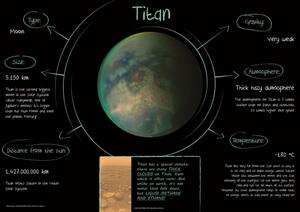Glossary term: Titan
Description: Titan is the largest moon of Saturn. It is larger than Earth's Moon and Mercury, and is second largest amongst the moons in the Solar System. It is the only body other than Earth known to have liquid oceans, seas, and rivers on the surface. These are, however, made up of chemicals called hydrocarbons. Titan is believed to have a rocky core and an ice-crust made of water. It is thought that the liquid water beneath the ice-crust could possibly harbor life. It has a thick atmosphere, made up mostly of nitrogen, that makes it look very smooth in pictures.
Related Terms:
See this term in other languages
Term and definition status: This term and its definition have been approved by a research astronomer and a teacher
The OAE Multilingual Glossary is a project of the IAU Office of Astronomy for Education (OAE) in collaboration with the IAU Office of Astronomy Outreach (OAO). The terms and definitions were chosen, written and reviewed by a collective effort from the OAE, the OAE Centers and Nodes, the OAE National Astronomy Education Coordinators (NAECs) and other volunteers. You can find a full list of credits here. All glossary terms and their definitions are released under a Creative Commons CC BY-4.0 license and should be credited to "IAU OAE".
Related Media
Titan in natural colours
Credit: NASA/JPL-Caltech/Space Science Institute credit link
License: PD Public Domain icons
Titan with surface features
Credit: NASA/JPL/University of Arizona/University of Idaho credit link
License: PD Public Domain icons
Related Activities
Children's Planetary Maps: Titan
astroEDU educational activity (links to astroEDU website) Description: Learn about the only other known body in the Solar System with Seas and LakesLicense: CC-BY-4.0 Creative Commons Attribution 4.0 International (CC BY 4.0) icons
Tags: Maps , Planetary cartography , Spatial thinking Age Ranges: 6-8 , 8-10 , 10-12 Education Level: Middle School , Primary , Secondary Areas of Learning: Social Research Costs: Low Cost Duration: 2 hours Group Size: Group Skills: Analysing and interpreting data , Asking questions , Communicating information , Constructing explanations , Developing and using models , Engaging in argument from evidence , Planning and carrying out investigations










